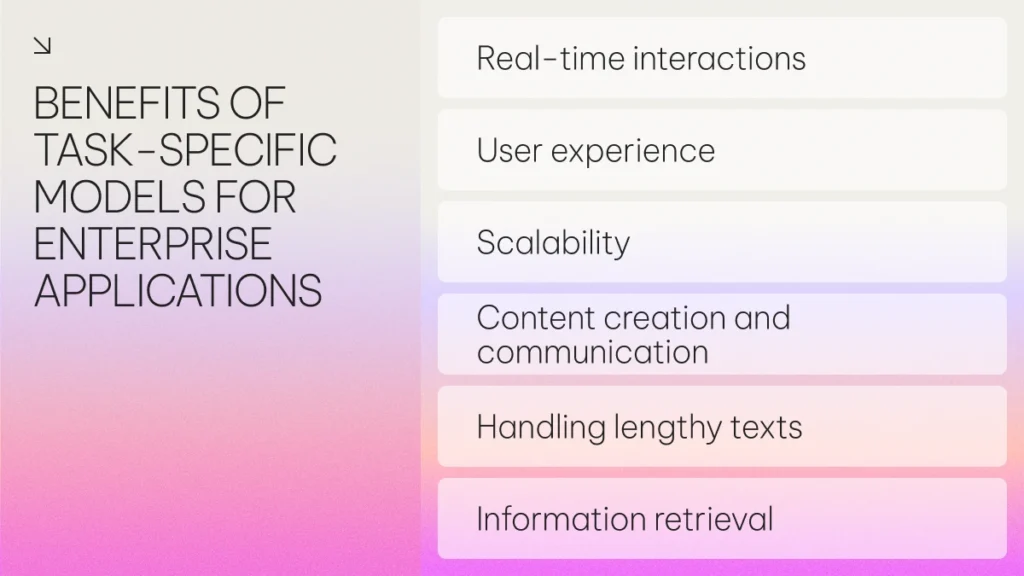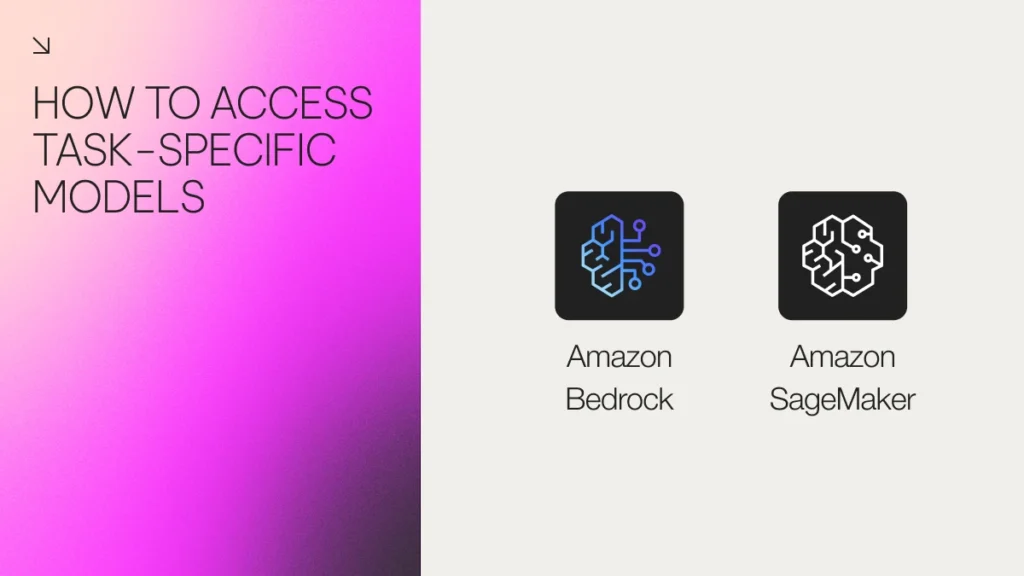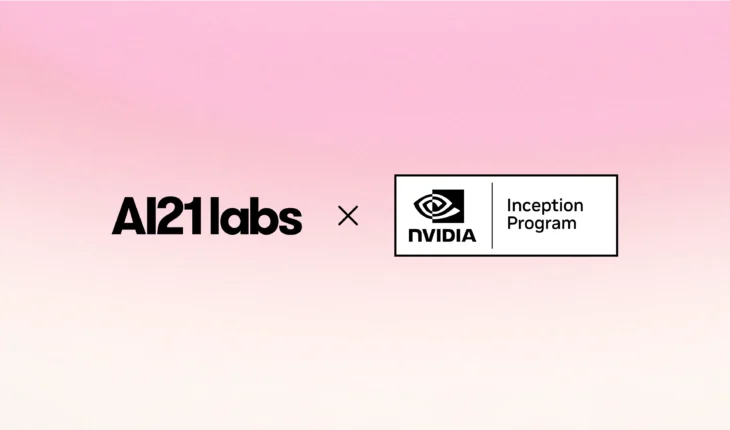Table of Contents

What are Task-Specific Models? Benefits & Applications
As large language models (LLMs) gain traction in the enterprise space, so do the risks of using them for high-stakes tasks.
LLMs are trained on general-purpose datasets — often comprising billions of text samples from sources like websites, books, and forums — enabling them to generate fluent, informative responses across a wide range of topics.
But this breadth comes at a cost: hallucinations (confidently incorrect outputs), embedded bias, lack of domain nuance, and an inconsistent grasp of context.
In fields like healthcare, finance, or retail, these limitations can result in more than just inefficiencies — they can jeopardize brand integrity, compromise decision-making accuracy, and even pose safety risks.
Task-specific models offer a smarter path forward for sectors that demand precision, compliance, and trust. In this article, we’ll explain what task-specific models are, and how to use them effectively in enterprise environments.
What is a task-specific model?
Task-specific models are AI systems designed with a narrow, well-defined focus and trained on domain-specific data.
Unlike general-purpose language models, they operate within a specialized scope — such as financial reporting, clinical documentation, or customer service automation — which reduces the risk of hallucinations or off-topic outputs that can arise from broader models.
They offer greater precision, faster response times (lower latency), and more consistent, context-aware results. Their focused design also makes it easier to implement strong safety, compliance, and quality guardrails.
In high-stakes environments, task-specific models provide a practical and reliable alternative to broad, general-purpose LLMs.
What is the difference between a task-specific model and an LLM?
General-purpose LLMs are designed for open-ended tasks that require broad knowledge gained from large-scale, general datasets. Their strength lies in adaptability and ease of access. However, they are prone to hallucinations (producing inaccurate or fabricated information), often require extensive prompt engineering to yield reliable outputs, and demand significant computational resources — making them less suitable for high-stakes, regulated environments.
Because LLMs cannot guarantee a specific or predictable output, they are less trustworthy for critical use cases that require accuracy, traceability, and compliance.
Task-specific models, in contrast, are generally smaller in size and complexity. They require less data and computing power to train, and because they are fine-tuned on domain-relevant data, they excel at completing well-defined natural language processing (NLP) tasks. This results in greater agility across deployment, scaling, and maintenance.
Their improved precision, faster inference times, and reduced complexity translate to lower operational costs and faster iteration — key advantages for enterprise adoption.
Here are a few other key differences:
- Security: When faced with a question that falls outside of their training data or context, task-specific models are less likely to fabricate an answer. Their constrained behavior helps prevent incorrect or incomplete information from being used in ways that could cause harm — especially important in finance, healthcare, and other sensitive sectors.
- Deployment: Because task-specific models are trained on domain-specific data, they are well suited to both cloud and on-premises deployment. This flexibility supports industries with strict compliance mandates or heightened data sensitivity.
- Compliance & Data Sovereignty: For regulated industries, the most reliable option is to deploy the model as self-hosted AI, containerized inside a VPC or on-prem hardware so that every prompt and response remains under corporate control.
- Agility: These models are typically more lightweight than general-purpose LLMs, making them faster to deploy, easier to scale, and simpler to maintain. This leads to greater responsiveness, lower latency, and reduced computational overhead — benefits that align directly with enterprise IT and operational goals.
| Category | General-purpose LLMs | Task-specific models |
| Purpose | Designed for open-ended, multi-domain tasks | Built for narrow, well-defined use cases |
| Training data | Trained on large-scale, general datasets | Fine-tuned on domain-specific data |
| Adaptability | Highly flexible across many use cases | Optimized for targeted performance |
| Accuracy | Prone to hallucinations and irrelevant outputs | Higher precision, lower risk of hallucination |
| Prompting | Often requires extensive prompt engineering | Performs reliably with minimal prompt tuning |
| Resources | High computational demands | Lower compute and storage requirements |
| Security | May generate incorrect or fabricated answers | Constrained behavior reduces misuse of incomplete data |
| Deployment | Typically cloud-based; harder to deploy on-prem | Flexible — cloud and on-premises options supported |
| Agility | Slower to deploy, scale, and maintain | Lightweight and agile for faster iteration cycles |
| Cost-efficiency | Costs grow with usage and prompt complexity | More economical at scale due to lower operational overhead |
| Use case fit | Better for general or exploratory tasks | Ideal for high-stakes, regulated, or repetitive enterprise tasks |
Benefits of task-specific models for enterprise applications
Task-specific models offer a range of advantages for enterprise environments — particularly in improving performance, efficiency, and reliability. Here are a few examples:
Real-time interactions
Because of their smaller size, task-specific models enable faster inference in real-time settings, resulting in quicker response times and reduced latency. This responsiveness is especially valuable for use cases like live customer support in retail or virtual medical assistants in healthcare, where timely interactions are essential.
User experience
Faster performance and higher output accuracy improve the overall user experience. Unlike general-purpose models, task-specific models are fine-tuned for specific domains, leading to more relevant, reliable results — which builds user trust and satisfaction.
Scalability
These models can be scaled up or down based on the use case. Their reduced computational demands make them more cost-effective and easier to adapt to changing workloads or infrastructure — particularly useful in high-volume enterprise environments.
Content creation and communication
While every organization is unique, task-specific models can generate consistent, on-brand messaging at scale. Because they operate only on approved, domain-specific data, they reduce the risk of off-brand or inaccurate content.
Handling lengthy texts
Effective communication — whether internal or external — often depends on distilling complex information. Task-specific models can summarize lengthy documents, making them ideal for reviewing financial reports, clinical documentation, or regulatory filings.
Information retrieval
Rather than guessing or generating fabricated answers, task-specific models extract precise, verifiable information from trusted sources. Their ability to respond strictly within the bounds of trained or ingested content improves both accuracy and accountability.

Applications of task-specific models
Task-specific models are increasingly being deployed across enterprise environments where precision, consistency, and efficiency are critical. Here are a few high-impact use cases:
Chatbot applications with Retrieval-Augmented Generation (RAG)
Task-specific models excel in chatbot applications, such as customer support, internal helpdesks, and specialized advisory bots, especially when combined with retrieval-augmented generation (RAG).
Unlike general-purpose LLMs, which may produce overly broad or inaccurate responses, task-specific models can be fine-tuned with domain-specific terminology and workflows. This ensures outputs are more accurate, relevant, and context-aware.
When enhanced with RAG — a technique that allows the model to query up-to-date external documents or databases — these chatbots can deliver highly reliable, grounded responses without hallucinating or guessing.
Real-time text classification
Real-time classification tasks, including spam detection, content moderation, and user feedback categorization, benefit significantly from task-specific models. These use cases often require high-speed, high-volume processing with low latency.
While LLMs can handle classification through carefully crafted prompts, task-specific models pre-trained on the exact classification schema generally outperform them in both speed and cost-efficiency. This leads to greater accuracy with fewer computational demands.
Document standardization
Task-specific models can also support document standardization by applying consistent tone, structure, and formatting across enterprise content. This is particularly valuable in legal writing, corporate communications, and regulatory submissions, where consistency is non-negotiable.
For example, by training on paired examples of original and reformatted documents, these models can learn to apply stylistic or structural changes without altering the underlying meaning. While general LLMs can perform similar tasks, task-specific models offer a more scalable and dependable path to consistency.
How to access task-specific models
Foundation models are trained on massive datasets to perform a broad range of tasks. But to tailor these models to enterprise-specific needs, fine-tuning and customization are required, which typically involves an investment of time, data, and resources.
Fortunately, there are accessible ways to get started, including low-code options that don’t require building models from scratch.

Amazon Bedrock
Amazon Bedrock provides API-based access to foundation models (FMs) from leading providers such as Anthropic, Cohere, AI21 Labs, Meta, and Amazon Titan — all without the need to manage underlying infrastructure.
With Bedrock, enterprises can fine-tune or customize models using internal documentation, knowledge bases, or proprietary datasets. This makes it easier to create task-specific models for functions like internal search, summarization, or compliance automation.
Bedrock also supports prompt engineering, allowing developers to craft system prompts tailored to specific tasks — a flexible alternative to full fine-tuning when speed or simplicity is key.
Amazon SageMaker
Amazon SageMaker is a fully managed machine learning (ML) platform that enables developers and data scientists to build, train, and deploy custom models at scale. Unlike Bedrock, which focuses on API access, SageMaker offers deeper model development capabilities.
Enterprises can explore multiple paths with SageMaker:
- Use low-code, prebuilt task-specific models via JumpStart
- Bring Your Own Model (BYOM) and host, monitor, and scale it
- Train custom models using built-in algorithms, custom code, and GPU-accelerated infrastructure
These tools make it easier for enterprises to create, operationalize, and manage task-specific models across various applications.
Weighing up the need for task-specific models
So, do you need a task-specific model?
To decide, start by assessing your accuracy requirements. Task-specific models are outperforming general-purpose LLMs across many enterprise use cases — particularly when applied to the narrow, high-value problems they’re built to solve.
For example, AI21’s Contextual Answers model has surpassed general-purpose foundation models in question-answering benchmarks. It excels in:
- Correctly distinguishing between answerable and unanswerable questions
- Reducing hallucinations by accurately identifying when no answer exists in the provided context
- Maintaining relevance, ensuring responses stay focused on the question’s intent without introducing unnecessary detail
These are the kinds of outcomes most enterprises want. If that sounds like your goal, the next consideration is cost — specifically, the trade-off between an upfront investment in fine-tuning and infrastructure versus the ongoing, usage-based pricing typical of large foundation models.
Fine-tuned models require early investment in areas like data labeling, infrastructure setup, and development. But at scale — especially in high-volume or repetitive tasks — this can become more economical than relying on large general models. With LLMs, multiple prompts, hallucinated outputs, and the need to load large context windows all drive up cost and complexity over time.
In short, the choice depends on your specific application requirements, the range of tasks involved, budget flexibility, and desired control over performance. But for many enterprise use cases, task-specific models offer clear long-term value.
The trend toward specialized, purpose-built AI isn’t going away. For enterprises focused on efficiency, reliability, and competitive differentiation, now is a smart time to get ahead of the curve.


